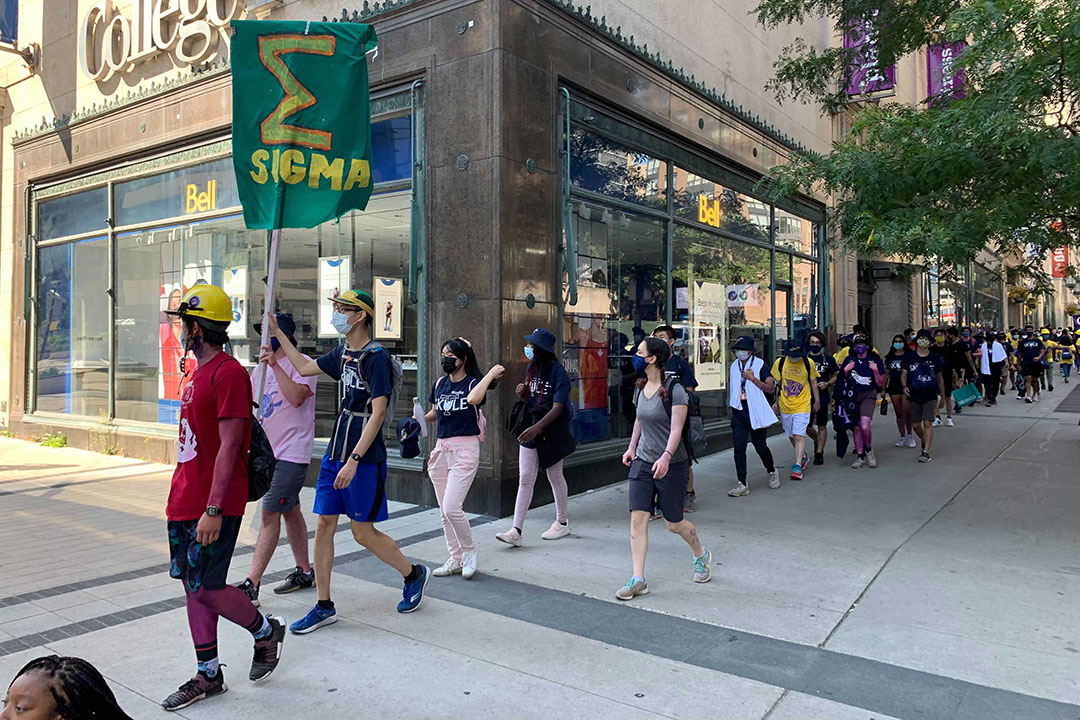For orientation week, from September 6–10, the Faculty of Applied Science & Engineering (FASE) held a set of partially online, partially in-person events to introduce first-year students to U of T.
Moving many of the faculty’s events online presented a unique challenge for orientation executives, who had to figure out how to introduce students to campus, the faculty, and each other through online activities.
The Varsity interviewed orientation executives and students participating in engineering orientation about how the faculty’s famously raucous orientation week moved its many traditions to a partially online format.
Keeping up traditions
While the nature of this year’s orientation week was vastly different from what first-year engineers have seen in the past, executives still found ways of passing on engineering orientation traditions.
Perhaps one of the best known traditions is the “purple dye” — an event where first-year students at orientation dye themselves purple. According to orientation chair Aidan Grenville, the tradition is a nod to engineers during the world wars, when Royal Navy engineers wore purple armbands that identified their jobs. In the hot engine rooms, the purple dye would sometimes bleed onto their skin, dying them purple.
“We continue to dye ourselves purple, sort of to honour these engineers and also to honour those who made the ultimate sacrifice and went down with these ships to… keep the ships afloat and the engines running to allow people to be evacuated,” said Grenville.
Repeating the tradition as usual was not feasible, not just because of COVID-19 safety concerns related to people jumping in the same pool of dye, but due to a Health Canada report from 2019 that linked the dye used in this orientation ritual to an increased risk of cancer. The practice was discontinued after the report.
This year, executives opted to use purple body paint, which is generally considered safe, rather than the traditional dye. They also noted that the process went much faster since the paint could be sprayed on.
Students at orientation also usually participate in the “Havenger Scunt,” a scavenger hunt with different activities that take place across the city. Traditionally, the event ends in “The Pit,” the location of many engineering events. This year, the event was moved online.
Executives also noted that the events gave some second-year orientation volunteers the opportunity to participate in events they missed during last year’s orientation, which was moved entirely online.
Other traditions also had to be reconsidered not only due to COVID-19, but due to changing attitudes. In the past, engineering chants and some other orientation week traditions have been the subject of criticism due to misogynistic lyrics and other culturally insensitive practices.
One tradition includes the statue in Queen’s Park, where engineers line up to kiss the horse’s testicles, which Grenville said was modified this year.
“[It’s] a long tradition that we’ve had, and it’s obviously something that we put a lot of critical thought into — like, is this what we want to be promoting?” said Grenville. “So this year, instead, we chose to sort of take a walk through Queen’s Park [and] stop by the horse [to] explain [that] it’s a good luck charm for first-years and to offer some alternative things, like… you could touch the hoof.”
He added that orientation leaders have been trying to explain where traditions come from, as well as explaining if and why they’ve chosen to alter them.
Student reflections
Dana Nepton, a first-year engineering student participating in orientation, said that the events and their associated traditions made her feel a sense of belonging within U of T.
“It makes me feel like it’s not just… hard work,” she said. “It’s very relaxed.”
Orientation leader Parsa Bondar Sahebi, a civil engineering student entering his third year, said that the in-person events were important for students’ transition into the university, and especially for their mental health.
“It just means a lot to most of us that we got the chance to plan at least this one day in person, because some days were online,” he said, later adding, “Speaking for myself, coming back to university and being on campus again, it just feels very good to me.”
In an interview with The Varsity, first-year engineering student Nifemi said that the orientation was a good way to meet older students and get oriented with U of T. She also said that the orientation lived up to her expectations.
Innovations
While this year’s engineering orientation was certainly unorthodox, many of its executives felt that it improved on past years.
“There [were] a lot of things that we missed because we’ve done them for so long and we have fond memories doing those things, but I don’t think that we weren’t able to replicate that experience in a meaningful way,” said Vice-Chair Marketing Kerryn van Rooyen, adding that she believes the restrictions actually contributed to “much better programming.”
One area where the executives noted a marked improvement was registration. Vice-Chair Internal Amanda Plotnik, who was in charge of the technical side of orientation, worked with the tech team to create a registration app specifically for the orientation.
“We’ve had problems in the past and registration gets just really drawn out, it goes way over time, people get really frustrated, and there’s people clustering and waiting for hours,” said Plotnik. “We just didn’t have that this year.”
Plotnik said the registration process was done by 9:00 am, before orientation began, and added that the online registration allowed for much more social distancing, since no one had to line up to register.


